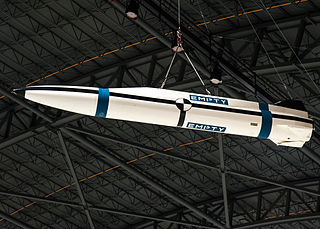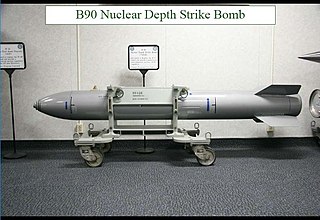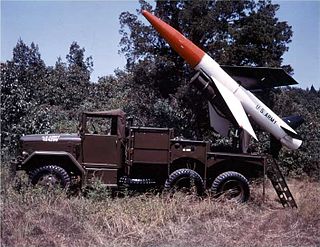
The UGM-27 Polaris missile was a two-stage solid-fueled nuclear-armed submarine-launched ballistic missile (SLBM). As the United States Navy's first SLBM, it served from 1961 to 1980.

Lawrence Livermore National Laboratory (LLNL) is a federally funded research and development center in Livermore, California, United States. Originally established in 1952, the laboratory now is sponsored by the United States Department of Energy and administered privately by Lawrence Livermore National Security, LLC.

The Boeing AGM-69 SRAM was a nuclear air-to-surface missile. It had a range of up to 110 nautical miles, and was intended to allow US Air Force strategic bombers to penetrate Soviet airspace by neutralizing surface-to-air missile defenses.

The B61 nuclear bomb is the primary thermonuclear gravity bomb in the United States Enduring Stockpile following the end of the Cold War. It is a low-to-intermediate yield strategic and tactical nuclear weapon featuring a two-stage radiation implosion design.

The Raduga Kh-15 or RKV-15 is a Russian hypersonic aero-ballistic air-to-ground missile carried by the Tupolev Tu-22M and other bombers. Originally developed as a standoff nuclear air-to-ground missile similar to the U.S. Air Force's AGM-69 SRAM, versions with conventional warheads have been developed.

The AGM-131 SRAM II was a nuclear air-to-surface missile intended as a replacement for the AGM-69 SRAM. The solid-fueled missile was to be dropped from a B-1B Lancer, carry the W89 warhead and have a range of 400 km. However, the program was canceled by President George H. W. Bush for geopolitical reasons just as the first flight-test missile was delivered.

The AGM-86 ALCM is an American subsonic air-launched cruise missile (ALCM) built by Boeing and operated by the United States Air Force. This missile was developed to increase the effectiveness and survivability of the Boeing B-52G and B-52H Stratofortress strategic bombers, allowing the aircraft to deliver its payload from a great distance. The missile dilutes an enemy's forces ability to respond and complicates air defense of its territory.

The MGM-5 Corporal missile was a nuclear-armed tactical surface-to-surface missile. It was the first guided weapon authorized by the United States to carry a nuclear warhead. A guided tactical ballistic missile, the Corporal could deliver either a nuclear fission, high-explosive, fragmentation or chemical warhead up to a range of 75 nautical miles (139 km).

The W80 is a low to intermediate yield two-stage thermonuclear warhead deployed by the U.S. enduring stockpile with a variable yield ("dial-a-yield") of 5 or 150 kilotonnes of TNT.

Nuclear weapons delivery is the technology and systems used to place a nuclear weapon at the position of detonation, on or near its target. Several methods have been developed to carry out this task.

The MGM-134A Midgetman, also known as the Small Intercontinental Ballistic Missile, was an intercontinental ballistic missile developed by the United States Air Force. The system was mobile and could be set up rapidly, allowing it to move to a new firing location after learning of an enemy missile launch. To attack the weapon, the enemy would have to blanket the area around its last known location with multiple warheads, using up a large percentage of their force for limited gains and no guarantee that all of the missiles would be destroyed. In such a scenario, the U.S. would retain enough of their forces for a successful counterstrike, thereby maintaining deterrence.

The W87 is an American thermonuclear missile warhead formerly deployed on the LGM-118A Peacekeeper ("MX") ICBM. 50 MX missiles were built, each carrying up to 10 W87 warheads in multiple independently targetable reentry vehicles (MIRV), and were deployed from 1986 to 2005. Starting in 2007, 250 of the W87 warheads from retired Peacekeeper missiles were retrofitted onto much older Minuteman III missiles, with one warhead per missile. An upgraded version is planned for use on the forthcoming LGM-35A Sentinel ICBM.
The Reliable Replacement Warhead (RRW) was a proposed new American nuclear warhead design and bomb family that was intended to be simple, reliable and to provide a long-lasting, low-maintenance future nuclear force for the United States. Initiated by the United States Congress in 2004, it became a centerpiece of the plans of the National Nuclear Security Administration (NNSA) to remake the nuclear weapons complex.

The W89 was an American thermonuclear warhead design intended for use on the AGM-131 SRAM II air to ground nuclear missile and the UUM-125 Sea Lance anti-submarine missile.

The B90 Nuclear Depth Strike Bomb (NDSB) was an American thermonuclear bomb designed at Los Alamos National Laboratory in the mid-to-late 1980s and cancelled prior to introduction into military service due to the end of the Cold War.

The W86 was an American earth-penetrating nuclear warhead, intended for use on the Pershing II intermediate-range ballistic missile (IRBM). The W86 design was canceled in September 1980 when the Pershing II missile mission shifted from destroying hardened targets to targeting soft targets at greater range. The W85 warhead, which had been developed in parallel with the W86, was used for all production Pershing II missiles.
The B61 Family is a series of nuclear weapons based on the B61 nuclear bomb.

The MGM-18 Lacrosse was a short-ranged tactical weapon intended for close support of ground troops. Its first flight test was in 1954 and was deployed by the United States Army beginning in 1959, despite being still in the development stage. The program's many technical hurdles proved too difficult to overcome and the missile was withdrawn from field service by 1964.
The W60 was nuclear warhead developed for the United States Navy's long range Typhon LR surface-to-air missile.
















